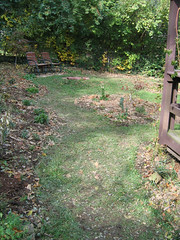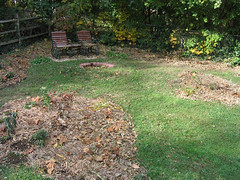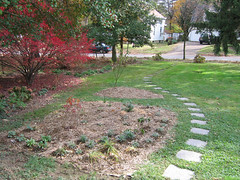Negative Space
I’ve always been fascinated with negative space. I mean that in the artistic sense, not the scientific, anti-matter and dark energy sense. I’m one of those people that will stare at the patterns in a hotel ballroom floor to study the shapes created in the space outside the fleur-de-lis. I look for the faces in Rubin’s vase. When I was in highschool I was obsessed with drawing giraffe spots on my papers. However, I didn’t draw the spots, but rather the winding paths around the spots. What I learned from this exercise was that concentrating on the negative space when creating a pattern can give you more fluid, natural results than focusing on the positive space.
I try to give the negative space that same, careful attention when I create new beds in our yard. The beds are the positive space, and the paths and lawn are the negative. By concentrating on creating interesting negative shapes, the resulting garden beds seem to relate to the overall landscape, instead of looking plopped into the lawn.
On the landscape design forum, on GardenWeb, the use of island beds (especially in the home garden) is hotly debated. Most people, rightly so, believe that island beds look artificial and stiff. They are usually composed of a small berm, planted with evergreens, floating in the middle of a sea of grass. I’ve seen quite a bit of discussion on the proper height, width, and length of an island bed in order for it to look integrated into the yard. I believe the guidelines can be pretty much disregarded if one merely concentrates on the negative space of the lawn. If the island bed’s creation results in a pleasing flow of grass or groundcover around it, it will not look unnatural.
 Enough with theory, though. I’d like to share some examples from my own yard. First, the pond area. When I added scallops to the candycane bed and a swoop to the bed in front of the deck, I realized that I had the opportunity to create exciting, winding grass paths in the negative space I had created. I added an island bed in the corner of lawn between the deck and candycane bed. Its contours mirror those of the two aforementioned beds and the round pond. I envisioned the beds and pond like the continents of Pangaea that had drifted away from each other over the grassy sea. Of course, my anal-retentive sense of balance forced me to add another island bed, on the other side of the pond area to balance the first. I adore the resulting, wandering paths and the symmetrical, if not quite circular, patch of grass carved out around the pond. The result is still a little raw (most of what you see here was created this past season), but I can imagine what it will look like when the dozens of bulbs I have planted here spring to life.
Enough with theory, though. I’d like to share some examples from my own yard. First, the pond area. When I added scallops to the candycane bed and a swoop to the bed in front of the deck, I realized that I had the opportunity to create exciting, winding grass paths in the negative space I had created. I added an island bed in the corner of lawn between the deck and candycane bed. Its contours mirror those of the two aforementioned beds and the round pond. I envisioned the beds and pond like the continents of Pangaea that had drifted away from each other over the grassy sea. Of course, my anal-retentive sense of balance forced me to add another island bed, on the other side of the pond area to balance the first. I adore the resulting, wandering paths and the symmetrical, if not quite circular, patch of grass carved out around the pond. The result is still a little raw (most of what you see here was created this past season), but I can imagine what it will look like when the dozens of bulbs I have planted here spring to life. 
 In the front yard, I laid the winding, stepping stone path with the intent of eventually creating beds along both sides of it. With our heavy clay soil, I can only provide the woman-power to create a limited number of beds each season. This year, I started with the first two beds on the shady side of the walk, near the house, inside a curve. I was initially going to make only one bed, but it seemed too large, so I cut it in two with a grass walkway. I’m not entirely pleased with the shapes. Looking at the positive space, the larger bed is disturbingly close to rectangular. The smaller bed, while objectively a good shape, creates a grass path of an odd width between it and the shady shrub border to the left. I plan on adjusting the edges of the shrub border to correct the problem. I’m stumped on the rectangular bed. I like the negative space around it, though, and I’m hoping that the bed’s geometric shape will be camouflaged when the plants fill in.
In the front yard, I laid the winding, stepping stone path with the intent of eventually creating beds along both sides of it. With our heavy clay soil, I can only provide the woman-power to create a limited number of beds each season. This year, I started with the first two beds on the shady side of the walk, near the house, inside a curve. I was initially going to make only one bed, but it seemed too large, so I cut it in two with a grass walkway. I’m not entirely pleased with the shapes. Looking at the positive space, the larger bed is disturbingly close to rectangular. The smaller bed, while objectively a good shape, creates a grass path of an odd width between it and the shady shrub border to the left. I plan on adjusting the edges of the shrub border to correct the problem. I’m stumped on the rectangular bed. I like the negative space around it, though, and I’m hoping that the bed’s geometric shape will be camouflaged when the plants fill in.
My garden design isn’t perfect, but I believe my negative technique is a valid one. As I pile leaves in areas of the lawn destined to be new shade beds next year, I pay careful attention to both the face (lawn) and the vase (bed). I’m currently scheming to figure out how I can create something similar to Susan’s oval lawn (which is a GREAT example of bringing the negative space to the focus). If you drive by and observe me raking leaves into odd patterns and squinting my eyes, you’ll know that I’m trying to achieve the perfect balance between the positive and negative.
I try to give the negative space that same, careful attention when I create new beds in our yard. The beds are the positive space, and the paths and lawn are the negative. By concentrating on creating interesting negative shapes, the resulting garden beds seem to relate to the overall landscape, instead of looking plopped into the lawn.
On the landscape design forum, on GardenWeb, the use of island beds (especially in the home garden) is hotly debated. Most people, rightly so, believe that island beds look artificial and stiff. They are usually composed of a small berm, planted with evergreens, floating in the middle of a sea of grass. I’ve seen quite a bit of discussion on the proper height, width, and length of an island bed in order for it to look integrated into the yard. I believe the guidelines can be pretty much disregarded if one merely concentrates on the negative space of the lawn. If the island bed’s creation results in a pleasing flow of grass or groundcover around it, it will not look unnatural.
 Enough with theory, though. I’d like to share some examples from my own yard. First, the pond area. When I added scallops to the candycane bed and a swoop to the bed in front of the deck, I realized that I had the opportunity to create exciting, winding grass paths in the negative space I had created. I added an island bed in the corner of lawn between the deck and candycane bed. Its contours mirror those of the two aforementioned beds and the round pond. I envisioned the beds and pond like the continents of Pangaea that had drifted away from each other over the grassy sea. Of course, my anal-retentive sense of balance forced me to add another island bed, on the other side of the pond area to balance the first. I adore the resulting, wandering paths and the symmetrical, if not quite circular, patch of grass carved out around the pond. The result is still a little raw (most of what you see here was created this past season), but I can imagine what it will look like when the dozens of bulbs I have planted here spring to life.
Enough with theory, though. I’d like to share some examples from my own yard. First, the pond area. When I added scallops to the candycane bed and a swoop to the bed in front of the deck, I realized that I had the opportunity to create exciting, winding grass paths in the negative space I had created. I added an island bed in the corner of lawn between the deck and candycane bed. Its contours mirror those of the two aforementioned beds and the round pond. I envisioned the beds and pond like the continents of Pangaea that had drifted away from each other over the grassy sea. Of course, my anal-retentive sense of balance forced me to add another island bed, on the other side of the pond area to balance the first. I adore the resulting, wandering paths and the symmetrical, if not quite circular, patch of grass carved out around the pond. The result is still a little raw (most of what you see here was created this past season), but I can imagine what it will look like when the dozens of bulbs I have planted here spring to life. 
 In the front yard, I laid the winding, stepping stone path with the intent of eventually creating beds along both sides of it. With our heavy clay soil, I can only provide the woman-power to create a limited number of beds each season. This year, I started with the first two beds on the shady side of the walk, near the house, inside a curve. I was initially going to make only one bed, but it seemed too large, so I cut it in two with a grass walkway. I’m not entirely pleased with the shapes. Looking at the positive space, the larger bed is disturbingly close to rectangular. The smaller bed, while objectively a good shape, creates a grass path of an odd width between it and the shady shrub border to the left. I plan on adjusting the edges of the shrub border to correct the problem. I’m stumped on the rectangular bed. I like the negative space around it, though, and I’m hoping that the bed’s geometric shape will be camouflaged when the plants fill in.
In the front yard, I laid the winding, stepping stone path with the intent of eventually creating beds along both sides of it. With our heavy clay soil, I can only provide the woman-power to create a limited number of beds each season. This year, I started with the first two beds on the shady side of the walk, near the house, inside a curve. I was initially going to make only one bed, but it seemed too large, so I cut it in two with a grass walkway. I’m not entirely pleased with the shapes. Looking at the positive space, the larger bed is disturbingly close to rectangular. The smaller bed, while objectively a good shape, creates a grass path of an odd width between it and the shady shrub border to the left. I plan on adjusting the edges of the shrub border to correct the problem. I’m stumped on the rectangular bed. I like the negative space around it, though, and I’m hoping that the bed’s geometric shape will be camouflaged when the plants fill in.My garden design isn’t perfect, but I believe my negative technique is a valid one. As I pile leaves in areas of the lawn destined to be new shade beds next year, I pay careful attention to both the face (lawn) and the vase (bed). I’m currently scheming to figure out how I can create something similar to Susan’s oval lawn (which is a GREAT example of bringing the negative space to the focus). If you drive by and observe me raking leaves into odd patterns and squinting my eyes, you’ll know that I’m trying to achieve the perfect balance between the positive and negative.


5 Comments:
My dad's recommendation is to always mow what you're willing to mow and let the garden conform to the rest. Getting a riding tractor in and around makes you think about the negative spaces more.
Your point about negative space is a good one to remember. I think sometimes that so much focus is spent on the garden beds it's easy to overlook what's going on in the landscape as a whole. And island beds are tricky...I made my first one this past summer. You're right that it's much more effective to focus on the space around it rather than the bed--which seems wrong somehow, but it's only through the size of the lawn space around the bed that you can judge whether the bed is the right size. Your yard is going to be gorgeous!!
I've been kinda doing the same thing. My goal is get rid of my lawn completely and just have paths between the beds but, like you, there is only me to dig the beds, so I've been enlarging/creating them gradually. I know where I want the paths to be eventually, so I am digging out the beds along that plan. I guess you could say that my negative space is slowly coming into focus.
What a great post. I agree that negative space isn't always used well in the garden... I know that I need to think about it more in mine.
Does focusing on the "negative space" in your garden make you a negative person? No way! Thanks for an interesting post that focuses on a different way of viewing one's garden or backyard.
Post a Comment
<< Home